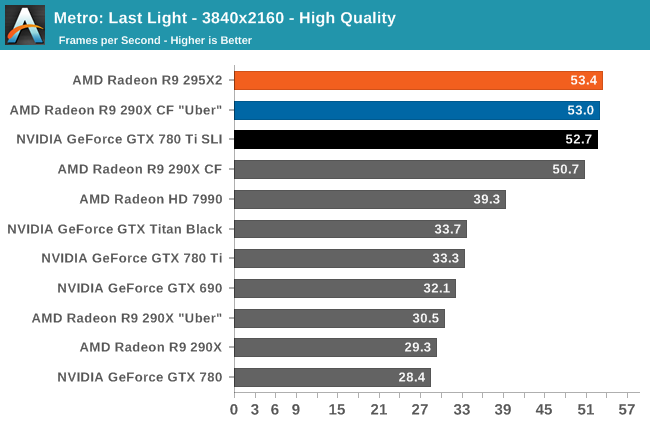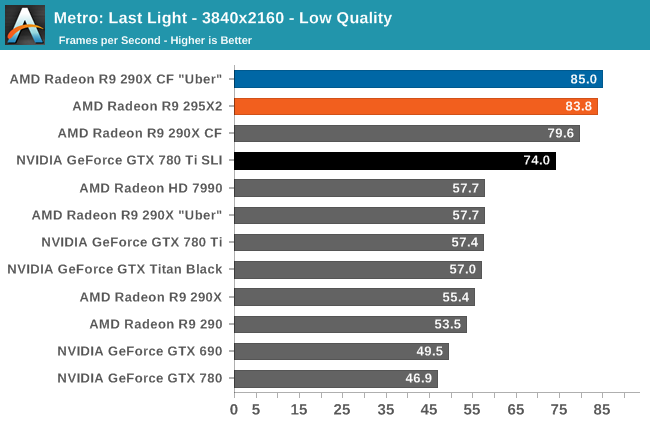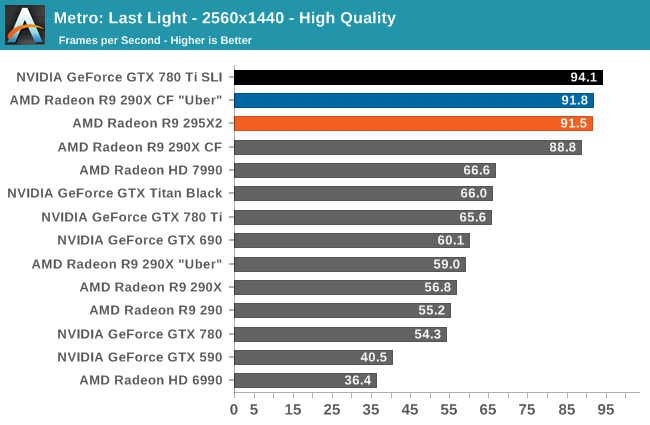The AMD Radeon R9 295X2 Review
by Ryan Smith on April 8, 2014 8:00 AM EST- Posted in
- GPUs
- AMD
- Radeon
- Radeon 200
Metro: Last Light
As always, kicking off our look at performance is 4A Games’ latest entry in their Metro series of subterranean shooters, Metro: Last Light. The original Metro: 2033 was a graphically punishing game for its time and Metro: Last Light is in its own right too. On the other hand it scales well with resolution and quality settings, so it’s still playable on lower end hardware.



Our first gaming benchmark pretty much sets the tone for what we’ll be seeing in this review. In building the 295X2 AMD set out to build a single card that could match the performance of the 290X “Uber” In Crossfire, and that is exactly what we see happening here. The 295X2 and 290XU CF swap places due to run-to-run variation, but ultimately both tie together, whether it’s above the GTX 780 Ti SLI or below it.
As we’ve already seen with the 290X, thanks in part to AMD’s ROP advantage, AMD’s strong suit is in very high resolutions. This leads to the 295X2 edging out the competition at 2160p, while being edged out itself at 1440p. None the less between AMD and NVIDIA setups this is a very close fight thus far, and will be throughout. As for Metro, even at the punishing resolution of 2160, the 295X2 is fast enough to keep this game going at above 50fps.










131 Comments
View All Comments
extide - Tuesday, April 8, 2014 - link
Did you misread the article? They are simply comparing the frame pacing on the old stuff to the new stuff. Unfortunately, most people are too stupid to properly comprehend english, which is pretty damn sad if you ask me. Thus, a lot of people are either mistakenly thinking that this card has bad frame pacing, or that this review had anything to do with the frame pacing updates for GCN 1.0. NEITHER of those things are the case!JDG1980 - Tuesday, April 8, 2014 - link
These two different things really shouldn't have been in the same article. It's confusing, unfocused, and comes off as taking cheap shots at AMD over an old product. Let's be honest, there weren't many 7990s sold in the first place, and anyone who bought one for gaming and was disappointed with it could have resold it during the mining craze and at least broken even, if not actually turning a profit. A review of a new product isn't the best place to say "Old product X is still not perfect".srsbsns - Tuesday, April 8, 2014 - link
Are the Battlefield 4 benchmarks using mantle or directx?Ryan Smith - Tuesday, April 8, 2014 - link
Direct3D.Blitzninjasensei - Saturday, July 12, 2014 - link
Ryan, would you be able to do a comparison with Mantle as well as D3D? I would like to see how much the benefit is.iamkyle - Tuesday, April 8, 2014 - link
So...they're taking the Prescott approach to performance?"Bigger!!! Faster!!! Hotter!!!"
Sounds like some Core2 Duo-type innovation is needed by AMD here to get temps and power down to a reasonable level here.
Mondozai - Tuesday, April 8, 2014 - link
Temperatures are out of control?Can you even read a basic chart or is that too much for your tiny little head to handle?
Da W - Tuesday, April 8, 2014 - link
Great EVGA GTX 780 superclocked to sell!Reason: bought too soon, i want this dual GPU bitch!
TheinsanegamerN - Friday, April 11, 2014 - link
I'll buy it. my 550ti is getting a little long in the toothMondozai - Tuesday, April 8, 2014 - link
Basically, for a few hundred dollars you are paying a premium on noise and GPU load compared to 2 R9-290X in Crossfire.While this card has a frame pacing improvement that is massive compared to 7990, it still trails 780 Ti in SLI. Although the 780 Ti is painfully gimped on 4K resolutions due to VRAM bottlenecks.
Maxwell's high-end cards in SLI is going to be beastly, since Nvidia is finally going to resolve the VRAM issue.